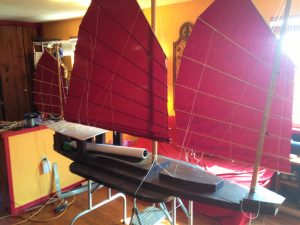Design
 We’ve decided on a junk rig and three chinese lug sails. The design is thousands of years old and has many benefits. About the only negative is that you cannot sail as close to the wind as with a Bermuda rigged boat, but we aren’t running a race, and half the fun is getting there. Read more about sail design…
We’ve decided on a junk rig and three chinese lug sails. The design is thousands of years old and has many benefits. About the only negative is that you cannot sail as close to the wind as with a Bermuda rigged boat, but we aren’t running a race, and half the fun is getting there. Read more about sail design…
Canvas
You can use just about anything to make chinese junk sails, in fact thousands of years ago, grass cloth was the norm. Plastic tarps, canvas, vinyl, old flower sacks, and even Scarlett O’hara’s drapes would work but we’re going to go with a fabric that is strong and can stand up to abrasion — 11 oz Top Gun in a burgundy shade similar to the old brownish-red Tanbark.
Why Top Gun?
Poly tarp will do in a pinch, but we really would like something more durable. Sunbrella at 9.5 ounces per yard was in the running for a while. It is commonly used for covers and awnings, but experience has shown that it has too much stretch and not great ability to resist chafing. And chafing is a common problem on junk rigs due to the battens pressing the sail against the mast. The experienced recommendation is for Top Gun at 11 ounces or Odyssey III at 6.5 ounces per yard. 11 ounces a yard does not sound like much, but a 1250 sq ft sail has over 150 yards by the time you make all of the seams and that comes out to about 100 pounds. Comparatively Dacron comes in 4 to 9 ounces but the yard measurement for material intended for sails is 36 by 28.5 inches. I’m going to blame that on the French. If you’re in or near the UK, then look for Richard Hayward brand sailcloth called Clipper Canvas. They make a cloth much like Top Gun.
Battens
The most noticeable feature of a junk rigged boat are the battens in the sail. Each batten works with the fabric and means that you can often utilize a lighter weight canvas. The reinforcement that backs the battens also works as a rip stop so if a sail does tear in one section, it will not spread to the areas above or below. Reefing also becomes easy with battens. But what material do you use? Learn more about battens
